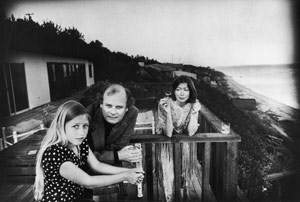 |
| Joan Didion, John Gregory Dunne and Quintana Roo Dunne in Malibu, California |
A great deal of the meaning in Joan Didion’s work can be found in the space between the words, in what is not said. Her detached, fragmentary style leaves the reader a whole lot of room. Like a scrim piece by artist Robert Irwin, you see the shadows, but you don’t quite know where you are, until the scrim parts and the moment of loss is sharp and clear.
Didion’s writing is precise, taut, yet elliptical. What is not told is purposeful. Her new book Blue Nights is about losing her daughter. The day after I finished the book I started reading it over again. I started to write a blog.
And then I got stuck.
Paul rushed to the bedroom, “Josh has been killed in a motorcycle accident.” Of course I didn’t believe him. It’s just what the mind/body does. Josh was Trudi’s son, who would have turned 30 on Christmas Eve. Trudi and Paul went to Dunsmore School together in Rugby, England, had lost touch (last contact 1978), but had reconnected on Facebook. She was from a group of kids who knew they were “other” and were going to find another way. Eventually Trudi and her family got out of Rugby by moving to a small town in France. We visited them in Ste Foy la Grande this past summer.
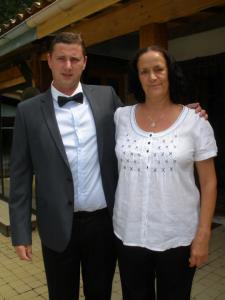 |
| Josh with his mum, Trudi, August 2011 |
Josh loved his motorcycle. He had posted on his Facebook page a few photos from a beautiful road trip he took a month ago. When we met him this summer, he was so kind to us, so sweet, so full of promise, with so much left to realize. Paul had started looking for a job for him in the French schools in San Francisco.
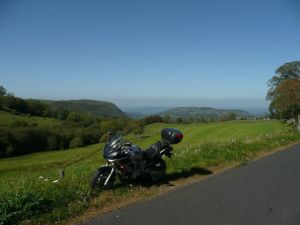 |
| Josh’s motorcycle |
When we had barbequed duck on the patio at his parents’ house near Bordeaux we tried to engage Josh in conversation, but he mostly listened. A few days later, we went to lunch at a fancy restaurant at one of the local chateaux. It was out of his way, and he would be late back to work, but when Trudi declared it important, he was present. There seemed to be a lot of latitude in Trudi’s childrearing, but family came first.
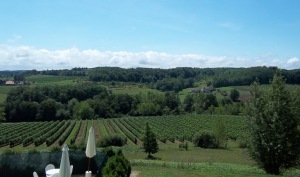 |
| The view from the restaurant where we had lunch with Trudi and her family. |
Joan Didion writes about illusion and loss, and perhaps the gift of loss is that illusion can be stripped away. Can we stay revealed and protected simultaneously? Today, I think not.
In her previous book, The Year of Magical Thinking, Didion examined the loss of her husband, the writer John Gregory Dunne. Her coolness balances the intimacy required to share the experience of losing a long-time partner – in life and work. But as Didion herself has pointed out in interviews, she doesn’t feel that she caused her husband’s death. She is less certain with her daughter, Quintana Roo, the subject of this new work and maybe much of her earlier work as well.
Quintana Roo Dunne died at 39 of natural causes, a flu that got worse and worse. Those are the facts. But what of the memories? What of all the scraps, the school uniforms, the early attempts at writing? One of the most quoted lines from the book (thus far) is “when we talk about mortality, we are talking about our children.” The death of Didion’s child foreshadows her own demise in a way she wasn’t prepared for. Nobody could be prepared.
There are Payard cakes; smart hotels (“on expense”); famous actors; homes in Malibu, Brentwood, and the Upper East Side; and lots of cashmere. Despite the relative comfort that success and privilege bring, it does not ease the loss of a child. There are also fears of bogeymen (here called “The Broken Man”), depressions, and alcoholism.
Every child who suffers from depression wonders how to measure this? How to gauge where it comes from? The fault of the individual who happened to be the parent, or the mix of genes that make up the self? One wonders how much influence the parent actually has anyway, short of physical or verbal abuse.
When someone dies, Quintana advises her mother, “Don’t dwell on it.” But she does. What decent parent wouldn’t?
On Sunday, I saw the obituary for the painter Barbara Winkelstein, the wife of architect Peter Winkelstein. She was a close friend of Al Baum, one of my oldest friends. For years, the portrait she painted of Al has hung in his home. Although Al is almost always smiling when we are together, she captured him in a moment of sadness, which I found interesting. He also had several paintings she did depicting Stinson Beach, one of my favorite places in the world. She was 82.
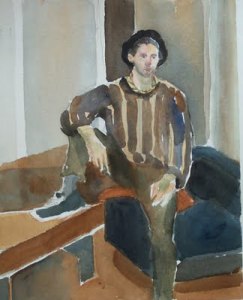 |
| Barbara Winkelstein painting |
Days later Tim, my good friend from New York, came to visit. His high school buddy Greg Klein had just moved to Florida with his new bride and was killed in a pedestrian accident. Greg was 53.
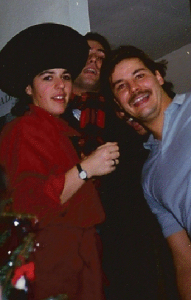 |
| Donna Kempner and Greg Klein in Tim’s NY apt. early 1980s |
I returned to the first paragraph of Didion’s The White Album: “We tell ourselves stories in order to live.” At the end of the paragraph, she elaborates: “We interpret what we see, select the most workable of the multiple choices. We live entirely, especially if we are writers, by the imposition of a narrative line upon disparate images, by the ‘ideas’ with which we have learned to freeze the shifting phantasmagoria which is our actual experience.”
All this loss.
The sky outside has a few clouds, but it all turns to steel wool. Paul tries to work on his opera. We wait for a friend to arrive to teach us about Twitter. I go to UC Berkeley to protest, to remind myself that something matters.
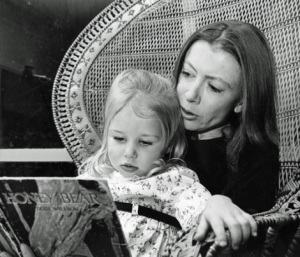 |
| Joan Didion and Quintana Roo |
More info:
You can see Griffin Dunne’s video of his aunt Joan Didion here:
http://joan-didion.info/2011/10/griffin-dunne-film/
You can see a recollection of Greg Klein here:
http://www.27east.com/news/article.cfm/East-End/405411/Remembering-the-Madhatter
You can see some of Barbara Winkelstein’s work here:
http://sites.google.com/site/bwinkpaintings/